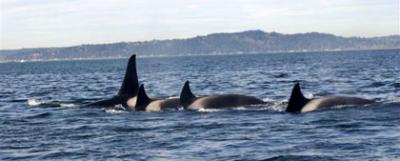
Killer Whale Kindred

Someone at Chez VHP has uncanny Kéet karma on his birthday. He just happened to look out the window on that stormy day and see tall dorsal fins approaching. Time for a council of kindred First Nations: Tlingit and Southern Resident. After a dreadful year fraught with health, housing, and financial crises, a serene, dignified celebration with the Canoes of Spirit was particularly rewarding.
As a bonus, like frosting roses on a dark chocolate cake, L Pod families we last saw in June off San Juan Island accompanied K Pod for the birthday encounter. Seeing these orcas again was slightly bittersweet in that their 79 year-old matriarch, Alexis (L12), died in 2012. Sometimes called the L12s, this group includes Mega (L41), born 1977, along with his sisters and nieces. Sister Matia (L77) has a spunky daughter, L119, who is about 7 months old. 84 year-old Ocean Sun (L25) is the other elder female who travels with the L12s. Spirit (L22) and her sons Skana (L79) and Solstice (L89) were present, too.
The four adult males of the L12 subgroup exhibit an impressive array of stately dorsal fins. L41 (Mega) is a stud in the tradition of J1 (Ruffles) – large males who have fathered many Southern Resident calves. Intriguingly, another male, Onyx (L87), a relative of Spirit (L22), now travels with J Pod elders Granny (J2) and Spieden (J8).
Coincidentally (or maybe not), Odin’s artwork graces the Seattle Aquarium’s orca trading card for Spirit (L22). Alexis (L12) and Ocean Sun (L25) are lovingly represented in our "Matriarchs" drum and wood carving design.
The L12 subgroup often travels without the rest of L Pod. Their half-day foray into Vashon-Maury waters was, thus far, the only known visit this winter from these enigmatic L Pod members. 24 hours later, the L12s and L22s were cruising out of the Strait of Juan de Fuca, headed toward the Pacific. They may not return to inland waters until spring.
On December 29, VHP associates as well as NOAA researchers witnessed an unprecedented event: Resident K Pod and Transient groups T30s and T124s traveling just hours apart through Vashon-Maury waters. This happens routinely in British Columbia and in the San Juans, but in my 18 years on Vashon, I have not seen Residents and Transients in such close proximity here.
This week’s photo shows the T30s from an earlier visit to Vashon, when they notoriously shredded a seal for hours. In contrast to his spiky-finned female relatives, adult male T30A has a softer, almost Resident-type dorsal fin. The T124s have also visited the Island previously in winter.
Revoltingly, when we photographed these Transients on the 29th, a small yacht was harassing them through Dalco Pass. Utterly oblivious to new vessel regulations for endangered killer whales, the yacht was barely 20 yards from the orcas – the revised approach distance is 200 yards. Rather than slowing down, the rude boater increased speed to match the fast-moving Transients who attempted to evade the yacht. To the orcas, that engine noise was equivalent to leaf blower noise to human ears.
Vessel impacts are more likely to occur in Island waters when the orcas’ locations are instantly available on social media. Are you part of the problem for our endangered Southern Residents? Then resolve to be more respectful in 2013.
Please support the work of the Vashon Hydrophone Project (VHP): REPORT LOCAL WHALE SIGHTINGS ASAP TO 463-9041, as well as sick, injured, or dead marine mammals on Island beaches. Ferry commuters, your calls matter in our research effort! Reporting directly to the VHP sustains an ongoing, accurate dataset of whale sightings for Vashon-Maury and nearby Central Puget Sound waters, initiated more than 30 years ago by researcher Mark Sears. Check for updates at Vashonorcas.org and send photos to Orca Annie at Vashonorcas@aol.com
- Login to post comments
